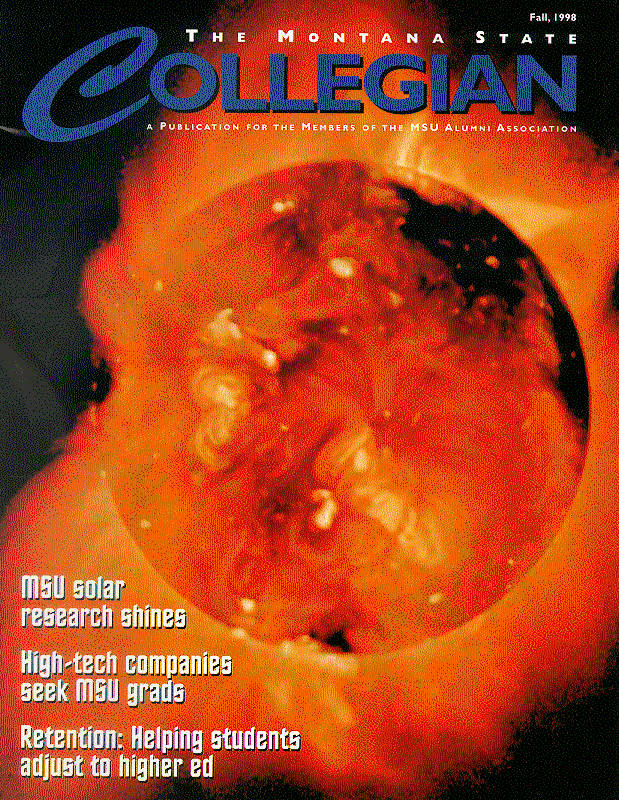Solar Physics Group in Fall Collegian
MSU scientists reach for the sun:
Cutting edge solar research by group headed by former astronaut draws international attention - By Evelyn Boswell

Scientists were probably thanking God for the U.S. military and unfired rockets when Loren Acton starting researching the heavenlies some 30 years ago.
For it was the military and the V-2 rockets they captured from the Germans (during
World War II) that made it possible for researchers to collect five-minute samples
above the atmosphere, explains Acton, now a research professor at Montana State University-Bozeman.
Acton, himself, sent his first experiment up in 1968 on an Aerobee, an American-made,
more user-friendly version of the German rocket.
These days, with his years as an astronaut and Lockheed employee behind him, Acton
is still exploring the universe, but the tools have become infinitely more sophisticated.
Acton, Richard Canfield and other members of the MSU Solar Physics Group now explore the sun by means of a Soft X-ray Telescope on the Yohkoh satellite. For the past seven years, the telescope has been taking pictures of the lower-energy, or "soft" x-rays of the sun and sending almost continuous images back to earth. The MSU scientists can watch those dramatic pictures simply by turning on the television monitors in their offices and laboratories.
"It's just wonderful how technology and the quality of our scientific questions has improved," Acton said recently. "It's really an exciting time to be a scientist." It's also an exciting time to be a solar physicist at MSU. With the advancements in technology and the leadership of Acton and Canfield, MSU's Solar Physics Group has experienced phenomenal growth and developed an international reputation, according to John Hermanson, head of the MSU physics department.
Acton, a 1959 graduate from Montana State College, founded the MSU Solar Physics Group after returning to MSU in 1993. Canfield, a long-time collaborator of Acton's, joined him here two years ago. Together with the other members of the Solar Physics Group, they are involved in a variety of projects that include undergraduate and graduate education, public outreach and solar resesarch. The projects are funded by the National Aeronautics and Space Administration (NASA) and the National Science Foundation (NSF).
"This group, which will include as many as 10 doctoral researchers this fall, is one of the best-funded groups at MSU and has made major contributions to education and outreach, as well as research," Hermanson commented.
MSU's Solar Physics Group has already hosted two national research conferences and
is planning a third for next summer.
Nature, one of the world's most prestigious journals for a broad scientific audience,
recently reported the findings of Acton, Eric Priest from St. Andrews University in
Scotland and a team of European scientists concerning the sun's outer region. The
scientists were trying to figure out why the sun's corona is so hot and came up with
a new clue that may explain why the corona is millions of degrees hot when the sun's
surface is only 6,000 degrees Celsius. It's probably caused by a clash of magnetic
fields, the researchers said.
The Solar Physics Group is also drawing hot, young scientists like Dana Longcope,
who came to MSU because of the group's reputation.
"This solar group is actually the best university solar group in the country," said
Longcope, an assistant professor in physics.
Longcope, himself, received a prestigious Faculty Early Career Development Grant to
help figure out the relationship between magnetic fields and x-rays on the sun's corona.
The 1998 grant from the NSF gives him an estimated $257,000 over four years to use
for both education and research. The grant is given to help promising scientists and
engineers develop their contributions to research and education early in their careers.
"We are fortunate at MSU to have people like Dana who does such a good job of integrating
teaching and research in a way that's mutually beneficial to both," Canfield said
upon the grant's announcement. "He really personifies the synthesis of teaching and
research."
Whether or not the Solar Physics Group continues to grow probably depends on grants
and the economy, Acton said. "Presumably, some time will come when it levels off or
shrinks," he noted. The potential for work, however, seems as unlimited as the universe
they explore.
Acton has already prepared a grant proposal that, if approved, would involve MSU in
placing another telescope on another Japanese satellite. This satellite would be much
bigger than Yohkoh and is scheduled to be launched in 2004. The telescope would be
10 times better than the Yokhoh telescope and, although costly, is needed to answer
the questions scientists are about to ask, Acton said.
Researchers still want to figure out why the corona is so much hotter than the sun's
surface, for example. They want to understand more about the relationship between
magnetism and solar flares. They want to figure out in general how the sun's magnetic
structure works.
"The central theme of the work that I have been doing, along with various collaborators
at MSU and elsewhere, is solar magnetic fields," Canfield said. "Magnetic fields on
the sun are one of the things that make it really interesting because we can observe
them quite directly. Not quite as directly as in the laboratory, say, but more directly
than any other star."
"I think it's pretty neat to be alive in a day when you can know enough about science, enough about physics, to design experiments which will give you information about the inside of a star," Acton said.
